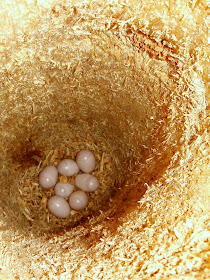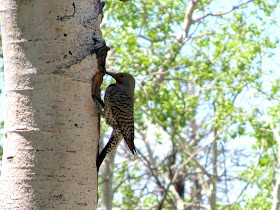
On yesterday's ride in the foothills of Pole Creek Mountain, our first clue was the wood chips on the ground beneath a dead aspen snag. Had someone been using a chain saw out here, at least a mile off any beaten path?
Then we saw a cavity in the tree.A head poked out
and a bird few away.We rigged up a makeshift ladder,
and Steve used his compass mirror and a light to look inside. The dug out chamber was more than a foot deep, and dark as a cave.
And then he set the camera on manual, adjusted the F-stop to 8, the shutter speed to 1000th of a second, and tucked the camera into the hole for a flash shot.
Yes, there were eggs! 7 of them. *
As soon as we moved away from the tree, Mr. Red-Shafted Flicker was back. He had eggs to tend until Mrs. Flicker arrived for her shift.
*The cavity nest is built by both male and female and takes 1-2 weeks to build. The male does most of the excavating, but the female prefers to do the detailing work herself. (Gee, that sounds a lot like how projects go at our house!) They prefer to build their own nest, but will sometimes refurbish and re-use an abandoned nest.








That nest is amazing! I had no idea any bird went to all that work to make a safe place for it's babies. i wonder, do they need to make a new one every year?
ReplyDeleteWhat a great find! 7 eggs! They are going to be busy feeding the babies before too long. I've never seen a nest like that, either.
ReplyDeleteThat was very interesting. I had no idea the holes in trees went so deep. Great photos to show and educate us all. I cannot imagine the time and effort it took to create that nest cavity. And to do such a tidy job at that. Amazing.
ReplyDeleteWow, that's really cool. That picture turned out amazingly well. We have been hearing a woodpecker near our house, building his/her own nest maybe.
ReplyDeleteWow, Janie, what a find and what a photo to show the interior of the nest. I'm glad the male returned to continue his shift. YEs, I've heard of birds who build and then the lady comes and adds feminine touches. This was such a wonderful post and Steve went to great lengths (0r should that be heights?) to share it. Have a great weekend. Jo
ReplyDeleteawesome....
ReplyDeleteSo cool! The picture of the eggs is fascinating.
ReplyDeleteI saw Blue-grey Gnatcatchers building a nest in the Red Butte Garden at the Univ. of Utah last weekend. I never ever would have spotted the nest if I hadn't seen all the bird activity.
That is so cool. I use the same trick with the camera while geocaching before sticking my hand in a cavity.Some consider it cheating.
ReplyDeleteWhat a find! Great shot of the nest, Steve!
ReplyDeleteReally fascinating. I was struck by the "chain saw" comment as a few years back I had a similar thought looking out to the back yard from our living room. It turned out to be the work of a pileated woodpecker excavating for carpenter ants on a big black cherry tree...
ReplyDeleteReally fascinating. I was struck by the "chain saw" comment as a few years back I had a similar thought looking out to the back yard from our living room. It turned out to be the work of a pileated woodpecker excavating for carpenter ants on a big black cherry tree...
ReplyDeleteWhat an exciting find! Wonderful visuals. Very clever that make-shift ladder and a beautiful shot of the eggs in the nest. Thanks Janie and Steve.
ReplyDeleteThat is so cool. I love how thorough you guys were with your documentation. It's sad that most of us just tend to obliviously walk past so many amazing things.
ReplyDeletehow awesome, I've never seen a flicker nest!great pictures today.
ReplyDeleteThat is so amazing....what a cool find. I am really impressed that you could get such a great photo of it too!!!!
ReplyDeleteI love how you took the shot of the eggs! I can't imagine climbing the tree to get that shot though. :)
ReplyDeleteFabulous photo of the interior of the nest. What a lot of hard work goes into the excavation of such a site.
ReplyDelete